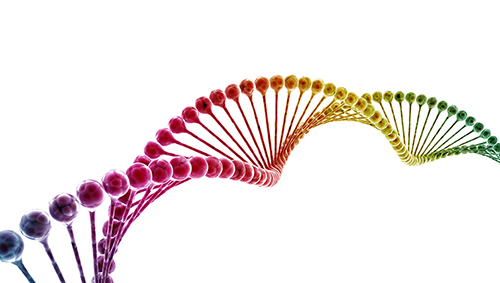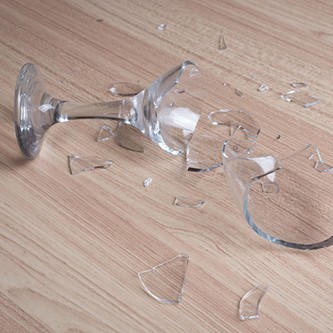英語記事に慣れる「サクっと読む英文」
2017.8.22
Scientists ‘print’ movie in bacteria DNA
Read the article to find out how and why scientists are storing information in DNA.
科学者たちがDNAの中に情報を保存している方法と、その理由について記事を読んでみましょう。

The idea of storing information in DNA is not new. Scientists have been using synthetic DNA (DNA created in a laboratory) to record data since 2012. DNA is very small and the information does not get lost over time. So, it has the potential to be used as a storage system for a lot of data in the future. In fact, scientists say that all of the world’s data could be stored in a volume of DNA about the size of two vans. However, storing data in living DNA is more challenging. Living DNA is always changing, which could affect the data written in it.
In this test, the Harvard scientists wrote the data for a black-and-white image of a human hand and a short black-and-white movie of a running horse into the DNA of E. coli bacteria. They used a code for each pixel of the image. The movie data was encoded one frame at a time, over a period of five days. The data were spread over a group of many bacteria. The bacteria were left to grow in a dish for one week. After that, the scientists collected the code from the bacteria’s DNA and used a program to recreate the image and the movie from the data.
The results were very positive. The scientists were able to recreate the hand image with 100% accuracy, and the movie with 90% accuracy. Although these data are still basic, this test shows that it is possible to store data in living DNA.
Scientists are hoping to use this technology in the future not only for storing data, but for recording changes over time in living organisms. This could be used to record changes inside human bodies to help fight disease, or to record environmental changes such as pollution.
However, there are some problems with this technology. First of all, at this point it is extremely expensive and cannot be used for everyday applications. Secondly, using this technology with living organisms has the potential of causing damage. For example, changing human DNA could create mistakes in the code, which might create diseases that will continue for many generations. Finally, there is a continuous debate regarding the ethics of changing human DNA.
It is clear that DNA technology is making great advances in recent years. However, it might be best to be careful before beginning to apply it to living organisms.
The technology of keeping information in DNA is not new. DNA is very small and it can keep information for a long time. So DNA could be used to keep a lot of data. Scientists say that all of the world’s data could be kept in DNA about the size of two vans.
Scientists have used synthetic DNA to record data since 2012. Synthetic DNA is made in a laboratory, not taken from living things. However, recording data in living DNA is more difficult. Living DNA is always changing, so the data written in it could also change.
In this test, the Harvard scientists used the DNA of E. coli bacteria. They chose a black-and-white image of a human hand and a short black-and-white movie of a running horse. The scientists then wrote the data for the image and the movie into the bacteria’s DNA using a code. The bacteria grew in a dish for one week. Then, the scientists took the data from the bacteria DNA and used it to remake the image and the movie.
The results were very good. The hand image made from the DNA data was 100% the same as the original image. The movie was 90% the same as the original movie. This test shows that it is possible to record data in living DNA.
In the future, scientists hope to use DNA technology not only for keeping data. They want to record changes over time in living things. They could record changes inside human bodies to stop illnesses. They could also record changes in the environment.
However, there are some problems with DNA technology. First, it is very expensive and cannot be used in daily life yet. Secondly, changing the DNA of living things could cause damage. Changing human DNA could create illnesses and other problems that will continue for a long time. Finally, many people worry about the moral questions of changing human DNA.
DNA research is making a lot of progress recently. However, people should probably be careful before using it a lot with living things.
キーフレーズ
potential 可能性(将来性)
あることが起きる可能性や発展性を意味します。
例:He has the potential to be very successful.
(彼は大きな成功を収める可能性を持っている。)
store ~を保存する、記憶する
synthetic 人工の
laboratory 研究所
get lost 迷う、失われる
over time 時間と共に
(長い)時間をかけて、徐々に、という意味です。
例:I didn’t like her at first, but I began to like her more over time.
(初めは彼女のことが好きではなかったが、時間が経つにつれて好きになり始めた。)
storage system 記憶(蓄積)システム
encode コード化する
over a period of ~ ~(の期間)にわたって
あることの持続(継続)期間を表すときに使われるフレーズです。
例:I watched the entire TV series over a period of a week.
(テレビシリーズの全話を一週間にわたって観た。)
accuracy 正確さ
living organism 生体、生命(有機)体
pollution 汚染、公害
application 利用、活用
continuous debate 絶えることのない議論
活発に談じられているものの結論に達することが難しい議論を意味します。
例:There is a continuous debate about the effectiveness of the medicine.
(薬剤の有効性については絶え間ない議論がある。)
類義語: ongoing debate


 【Gabaからのお知らせ】
【Gabaからのお知らせ】 【Gabaからのお知らせ】
【Gabaからのお知らせ】 【特集】
【特集】 【英単語の正しい使い分け】
【英単語の正しい使い分け】 【使いこなす句動詞】
【使いこなす句動詞】